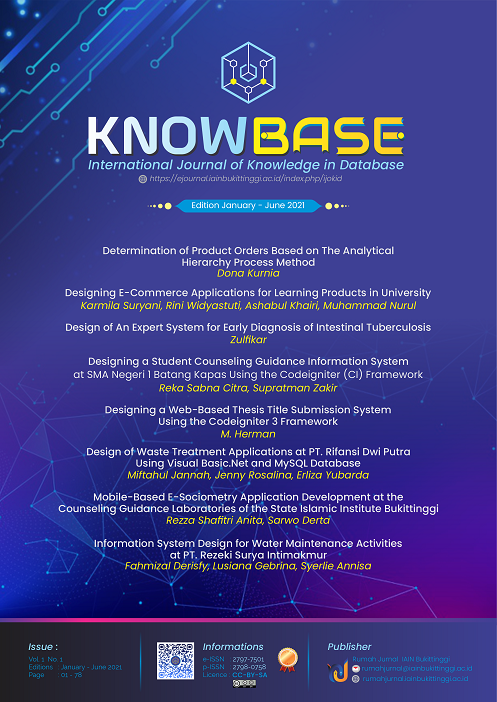Design of Waste Treatment Applications at PT. Rifansi Dwi Putra Using Visual Basic.Net and MySQL Database
DOI:
https://doi.org/10.30983/ijokid.v1i1.5079Keywords:
Waste, Visual Basic, MySQL, WaterfallAbstract
PT. Rifansi Dwi Putra is a company that operates in the Oil and Gas Industry, especially in the Waste Handling Transportation (WHT) Project regarding Waste Transportation. PT. Rifansi Dwi Putra especially at the Sand Management Facility (SMF) in processing waste volume data already uses a computer and is supported by Microsoft Excel software. However, doing data input, searching, processing, and reporting takes a relatively long time. So that the resulting information is less accurate, thus requests for fast and accurate information are often late in presenting their reports. In this regard, to facilitate the process of data accuracy, it is better to create an application for data collection of waste volumes using Visual Basic Programming Language and MySQL database. To facilitate the operations department, especially in recording the volume of waste transported to the Sand Management Facility (SMF) and making reports on the volume of waste to control, repair, and process data based on information technology and help the obstacles faced. To produce applications in waste volume data collection to facilitate structured data input in the data entry process, make it easier to search waste volume data, and help the management team produce accurate waste volume reports, making it easier to make decisions. The user of this application is only owned by one person because it is still a single user or stand alone (desktop-based) and this application produces three reports, namely reports per day, reports per month and reports per unit.
References
H. Nopriandi, F. Teknik, U. Islam, K. Singingi, and T. Kuantan, “Perancangan sistem informasi registrasi mahasiswa,†vol. 1, no. 1, pp. 73–79, 2018.
K. C. Antasari, “Informasi Pada Kinerja Individual Dengan,†E-Jurnal Akunt. Univ. Udayana, vol. 2, pp. 354–369, 2016.
P. Limbah et al., “Pengelolaan Limbah B3 dan Keluhan Kesehatan Pekerja di PT. Inka (persero) Kota Madiun,†pp. 118–127, 2017.
I. G. S. Widharma, “Berbasis Web Dengan Metode SDLC,†pp. 38–41, 2017.
Y. Firmansyah, “Penerapan Metode SDLC Waterfall Dalam Pembuatan Sistem Informasi Akademik Berbasis Web Studi Kasus Pondok Pesantren Al-Habi Sholeh Kabupaten Kubu Raya , Kalimantan Barat,†vol. 4, no. 1, 2018.
R. Irviani et al., “Aplikasi Perpustakaan Pada SMA N1 Kelumbayan Barat Menggunakan Visual Basic,†vol. 8, no. 1, 2017.
D. Menggunakan and P. H. P. Dan, “L e n t e r a d u m a i ,†vol. 10, pp. 46–57, 2019.
F. Fatmawati and J. Munajat, “Implementasi Model Waterfall Pada Sistem Informasi Persediaan Barang Berbasis Web,†Media Inform. Budidarma, vol. 2, no. 2, pp. 1–9, 2018.
Downloads
Published
How to Cite
Issue
Section
Citation Check
License
Authors who publish with this journal agree to the following terms:
- Authors retain copyright and grant the journal right of first publication with the work simultaneously licensed under a Creative Commons Attribution License that allows others to share the work with an acknowledgment of the work's authorship and initial publication in this journal.
- Authors are able to enter into separate, additional contractual arrangements for the non-exclusive distribution of the journal's published version of the work (e.g., post it to an institutional repository or publish it in a book), with an acknowledgment of its initial publication in this journal.
- Authors are permitted and encouraged to post their work online (e.g., in institutional repositories or on their website) prior to and during the submission process, as it can lead to productive exchanges, as well as earlier and greater citation of published work (See The Effect of Open Access).



